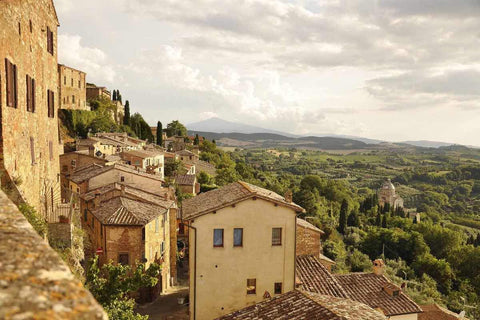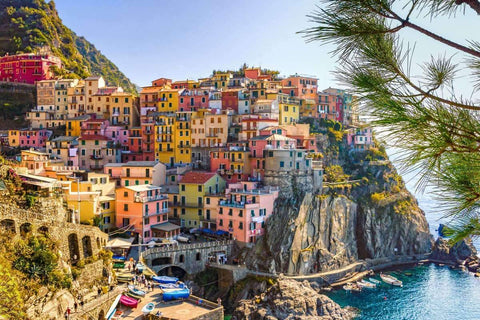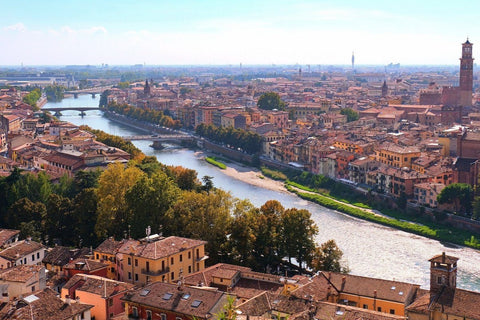Regarded as the birthplace of the Italian Renaissance and beloved for its picturesque villages, cypress-lined country roads, and bountiful vineyards, Tuscany (Toscana) is the most famous wine region in all of Italy. Bordering Tuscany to the north is Liguria and Emilia-Romagna, to the east is Umbria and Marche Lazio is situated to the south.
Winemaking practices in Tuscany date back to 8th Century BC when the Etruscans called the region home. In 1710, the first flask of Tuscan wine crossed the border, putting Sangiovese grapes and the famous Chianti wine on the map. For many years following, Chianti wine, a massive export of Tuscany to this day, was met with attention and praise. However, the production of this wine was greatly impacted by the devastation of vineyards during WWII and many Tuscan winemakers struggled as a result.
Since then, however, Tuscany has produced some of the most reputable wines on the planet and is one of the most prolific wine regions in all of Europe. There are over 157,000 acres of vineyards spread across Tuscany that collectively produce around 7.3 million ounces of wine every year. Tuscany is divided into 10 provinces: Firenze, Arezzo, Grosseto, Livorno, Lucca, Massa-Carrara, Pisa, Pistoia, Prato, and Siena. Each region is distinct from the others despite their proximity to one another.
THE TERROIR OF TUSCANY
Tuscany’s varied terrain and complex topography play a significant role in the flavor and cultivation of grapes within the region. Tuscany’s western coastline meets the Ligurian and the Tyrrhenian Sea, which affects the salinity of the wine made near those coastal areas. The Tusco-Emilian Apennine mountains curve around the northern border of the region and the various mountains and hillsides sprinkled throughout greatly impact Tuscany’s viticulture. Sangiovese, Tuscany’s most beloved grape, thrives on the hillside vineyards in the Chianti zone, while Cabernet Sauvignon flourishes in the warmer areas by the sea.
In coastal areas, the temperature is consistently warm whereas diurnal temperature fluctuations occur in the more inland areas along the hillsides. The drastic diurnal shifts create a perfect balance in temperature for the cultivation of vines, acting as a mediator for the grapes’ sugar and acidity levels. These shifts also give the region a soil-building freeze and thaw cycle, which helps to protect the vines during harsh winters.
In the Apennine foothills, the soil ranges from marl-like clay-limestone to dense sandstone. Around San Gimignano, the terroir consists of sandy clay and in the Bolgheri area, the soil is very clay and sand-based.
THE WHITE WINES OF TUSCANY
Trebbiano – this grape is planted throughout Italy but the Trebbiano grapes grown in Tuscany produce particularly delicious wines. Trebbiano wines are acidic with flavors of white peach, lemon, green apple, and basil. Trebbiano is also used as a blending grape. It is combined with Malvasia to create Vin Santo, or, “holy wine”, which is a dessert wine native to Tuscany. Traditionally Cantucci (biscotti) are dipped in Vin Santo as a special after-dinner treat.
Vernaccia – this is one of the region’s most historic wines. It is straw yellow in color and has aromas of stone fruit and citrus. On the palate, you can detect notes of lemon zest and hints of anise and almonds.
THE RED WINES OF TUSCANY
Sangiovese – the most widely planted grape in Tuscany and the main variety grown in Chianti, Vino Nobile di Montepulciano, and Brunello di Montalcino is Sangiovese. The grape grows best in the region’s hillside vineyards. Sangiovese produces a medium to full-bodied wine with lively acidity and firm tannins. The flavors can be earthy with spicy, and smoky notes. Wines made from this grape age extremely well.
Canaiolo Nero – this is a distinctive Tuscan black-skinned red wine variety. Canaiolo Negro is often a key component in the blending of Sangiovese wines. The wines produced out of this red wine grape variety are soft and mellow. Additionally, these wines have gentle tannins and herbaceous undertones.
THE CUISINE OF TUSCANY
Fantastic wine regions are often also home to fantastic local cuisine, and Tuscany’s gastronomical contributions are nothing short of mouthwatering. Tuscan food is based on the Italian term “cucina povera” (meaning poor or peasant cooking), but do not let this mislead you: the quality of this food is unsurpassed. Chefs and locals of the region pride themselves on their use of simple, fresh, high-quality ingredients acquired from local farms.
A typical Tuscan meal might include a hearty soup accompanied by freshly baked bread. Ribollita is a vegetable and bread soup that is the pinnacle of Tuscan comfort food. Another popular soup is the Pappa al Pomodoro, which is a tomato-based soup perfect for the wintertime. Panzanella is a commonly-served antipasto. It is made with bread soaked in balsamic vinegar and mixed with onions, tomatoes, and basil. Bistecca Fiorentina is another staple of Tuscan cuisine. It is a large T-bone steak that requires a very specific preparation process. The Florentine steak is cooked on embers or a grill and usually weighs between three and four pounds.
Tuscans are known for their love of beans, so much so that they’ve earned the name Mangia-Fagioli, which translates to “bean eaters”. Tuscany is famous for a plethora of bean dishes including Fagioli all’uccelletto. Cannellini beans are cooked in large terracotta pots with tomatoes, garlic, and sage to make Fagioli all’uccelletto.
Another famous Tuscan export is their truffles, which are used in many traditional dishes. Tagliatelle al tartufo is a decadent pasta dish covered in truffle sauce. Both white and black truffles are often found growing in the Tuscan hills and are a luxurious delicacy. If you’re planning a trip to Tuscany, eating a truffle-filled dish should be at the top of your bucket list!
Author: Melissa Norton ©



